PROJECT PROGRESSION
Proposal Stage
First Draft Proposal
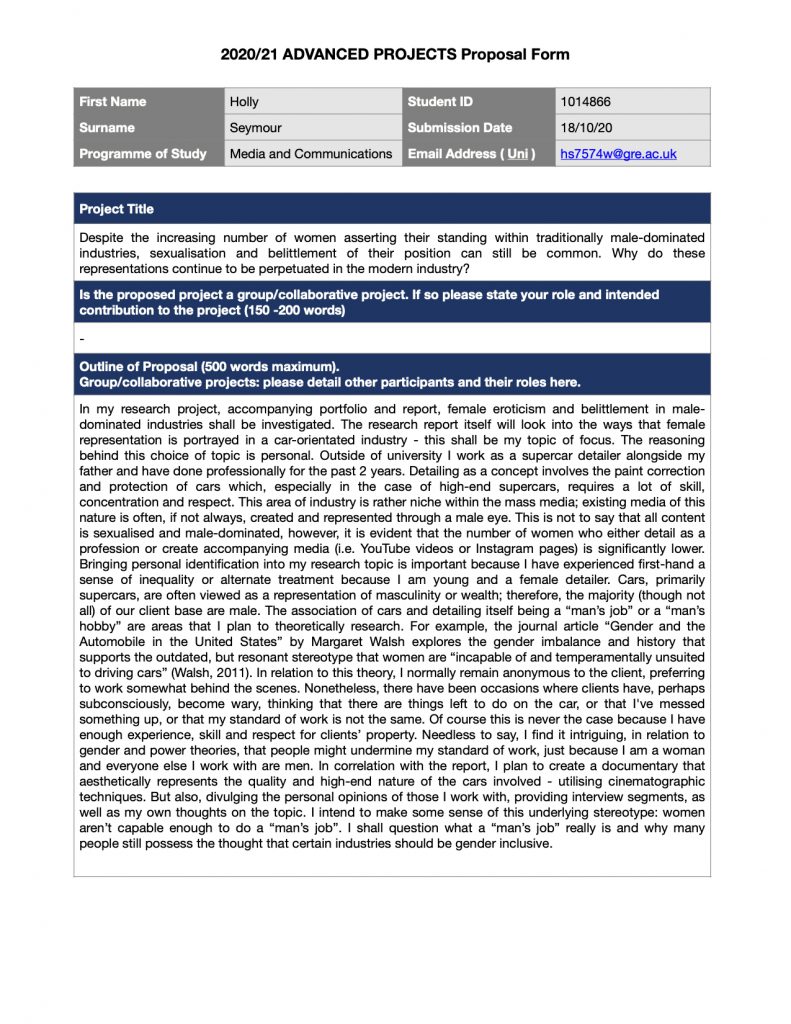
Final Proposal
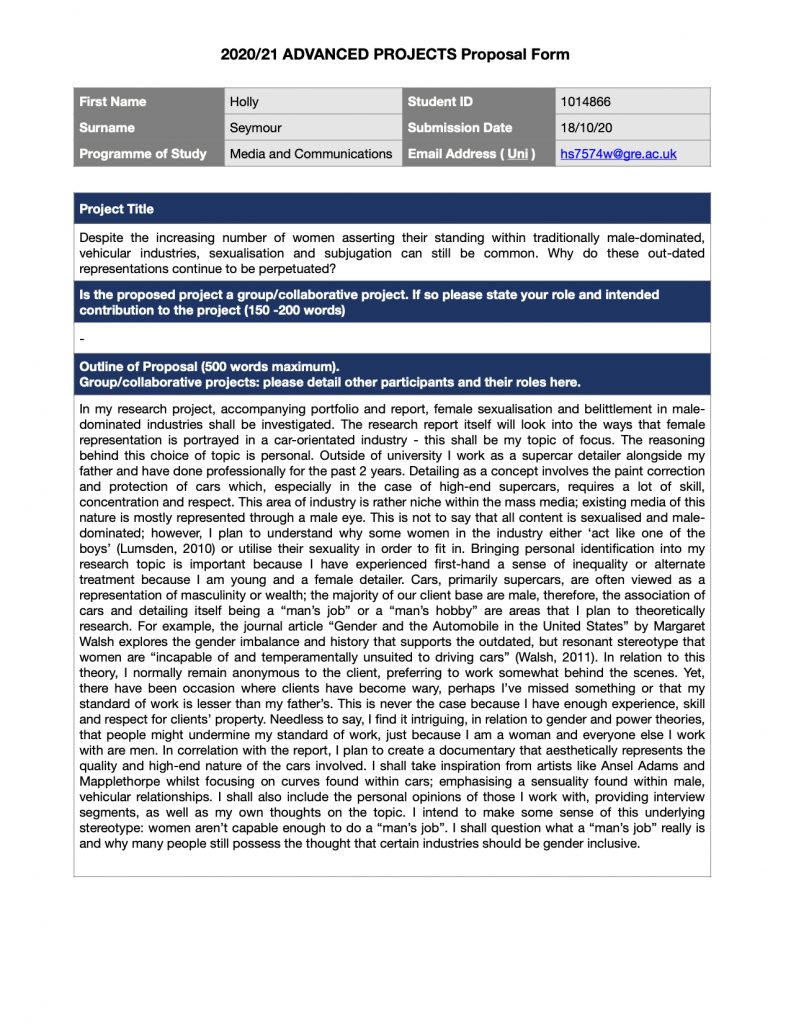
As mentioned in the Project Management section of this portfolio, the proposal only took two main attempts in order to refine. After a session with my supervisor, the main points that needed changing/adding were:
- Changing the focus from female ‘eroticism’ to female sexualisation so that the concept of sensuality and femininity can be explored in more detail, rather than entirely voyeuristic behaviour.
- More theoretical analysis, to which I researched and included a quote from Karen Lumsden’s (2010) work in regard to gender performativity. This furthered my research into whether women in the detailing industry perhaps manipulate their representations of femininity in order to either appease or disregard a heterosexual male audience.
- Including photographers like Mapplethorpe and Ansel Adams, allowing further aesthetic analysis that both aided the Interim Report and provided cinematographic inspiration in the final documentary.
Autoethnographic Practice
The decision to use autoethnographic documentary practice throughout the project stems from the personal nature of the topic itself. My supervisor and myself decided during sessions that this would be the predominant form of documentary practice, and would allow both the documentary and Interim Report to show my own intentions for the whole project. I did not simply choose this project because it is interesting, being a member of the demographic has encouraged me to wonder why is it that female detailers are both underrepresented and misinterpreted in the industry. Initially I used my own personal anecdotes, however, my sister, who I work alongside, also provides an interesting standpoint because she was only sixteen when she began working in the detailing industry. Furthermore, I decided that both of our presences within the documentary would emphasise how outdated and unrealistic the stereotypes investigated are. This is especially exaggerated by the fact that we are both young women, and yet are perfectly capable of handling the machinery that, according to stereotypical assumptions, we should not be able to use.
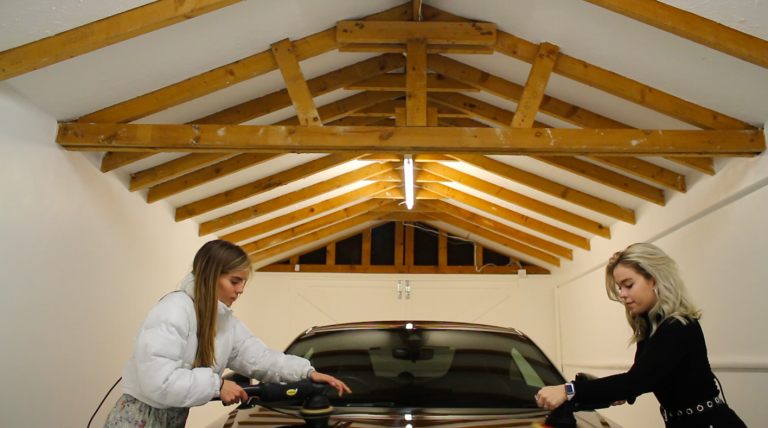
Critique Sessions
Moodboard
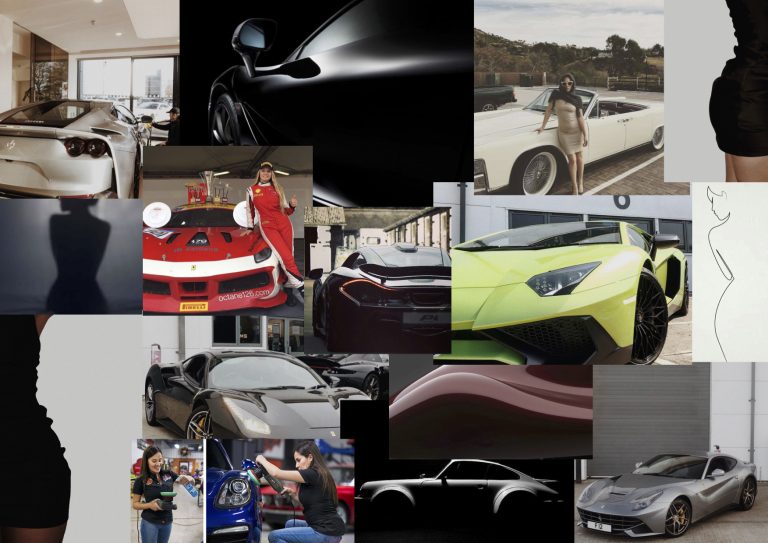
This moodboard was presented in the first critique session with another supervisor’s group. I first presented this moodboard which encapsulates the existence of a sensual association amongst women and cars. After taking the two similar images in a black dress myself, I decided to compare the curves prevalent in the bodywork of cars with the curves possessed by women as a response to Iqani’s (2012) article Smooth bodywork: the role of texture in images of cars and women on consumer magazine covers. For decades, women have been used in car advertisements (as shown in the image below), because it creates a level of aspiration for a heterosexual male audience. Therefore, through creating the moodboard, I wanted to show my critique group the similarities between the aesthetic representation of the car and women. The silhouette-style images show a level of smoothness, which according to Iquani (2012), replicates an attribute associated with femininity. In the images taken by myself, I intentionally wore a black satin dress in order to show the aesthetic similarity between myself and the car images.
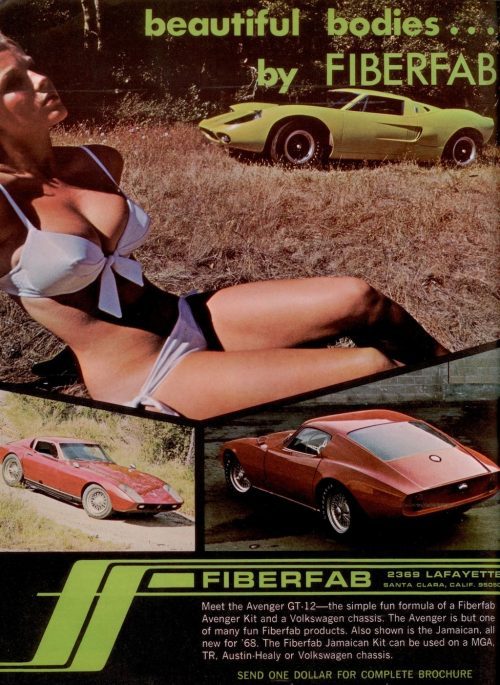
https://mycarquest.com/2014/12/car-advertisements-and-beautiful-women.html
First Draft Video
This is the first experiment with video, presented in the first critique session. After initially explaining my topic and showing the creative works, some students remained slightly unaware of the topic itself and what the intentions of my project were. This prompted me to make sure that, in the final documentary, the topic of research and the detailing industry appeared as clear as possible to audiences. Using a voiceover seemed the best way to explain what car detailing is, alongside visual representation of the process itself. Furthermore, one student commented that his knowledge, in relation to the topic, was YouTuber Supercar Blondie who is a car enthusiast rather than someone who physically works in the industry. I found this interesting because I was unaware of her social media presence and my first assumption, due to her username, was that perhaps she represents herself in an overtly feminine or somewhat sexualised manner. I had previously carried out some research into female detailers on social media and those with similar usernames to Supercar Blondie often presented themselves in a way that gained unwanted sexual comments or possessed a predominantly male following. Of course, this simply reinforces the stereotype that certain demographics of heterosexual men interpret women representing their sexuality as enticing or attractive, especially in relation to cars. Supercar Blondie actually represents herself in quite a neutral manner, and the nature of her comments, alongside her following of over six million subscribers, actually suggest that audiences are more interested in the cars shown on her channel than making outdated assumptions based on her femininity. This thought process encouraged me to continue researching other female detailers on social media and analyse whether content appeals to an element of the Male Gaze (Mulvey, 1989) or whether they choose to remain gender neutral in representation.
Second Draft Video
After presenting this second draft video in a supervision session, it was suggested that the different types of content involved were effective, however the music wasn’t quite fitting, or necessary throughout the whole video. As a result of this, in the actual documentary, the music is less neutral and piano-based and instead appears more dramatic and uplifting; the nature of what myself and my sister do is quite powerful and a feminist statement, therefore, I wanted this to reflect through the music. Furthermore, both supervisors suggested that the relaxed and personal nature of the interview with my sister works effectively to represent our close dynamic and our shared experiences. They suggested even the blooper clip, involving the dogs barking at the end, provided a comedic nature which shall engage audiences and provide relatability. Hence, I carried this personal approach into the final documentary, including segments that represent the realistic elements of our working life and sisterly dynamic.
Third Draft Video
This final draft, made before the official production process, showcases the machine polishers used when detailing. This video is very basic, however, my supervisor suggested that I experiment with representing each machine polisher against a plain background as it could work as a potential segment within the final documentary. After experimenting with positioning, lighting and a voiceover, in the final production the segment did not quite fit into the narrative. Moreover, when shooting the documentary, moving shots involving the machine polishers appear more effective than static ones. The speed and proper usage of the machine polishers, in moving shots, clearly shows the strength and precision required to use them. Finally, because the overall intention of the documentary is to explore outdated representations of female detailers and why they still exist within the Media, going to much into detail regarding the machine polishers may have caused confusion for audiences. Taking note from the critique sessions, many students did not fully understand the concept of detailing but understood my critique of gender representations in the detailing industry. Therefore, whilst also taking into consideration audience engagement in regard to the length of the documentary, I decided that my explanation of detailing, alongside the frequent representation of each machine polisher, was adequate.
